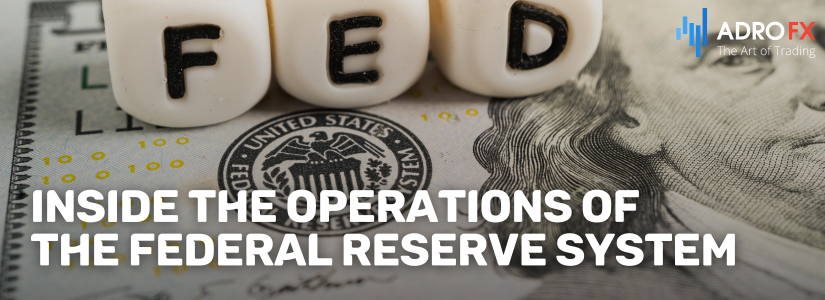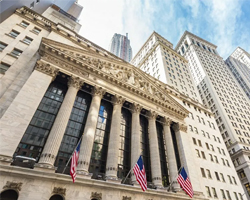Money Talks: Inside the Operations of the Federal Reserve System

In the intricate dance of economic management within the United States, the Federal Reserve System, affectionately known as the Fed, holds center stage. Charged with overseeing the nation's financial stability, the Fed's mandates span from fostering robust employment to steering sustainable economic growth. Its influence, wielded through a spectrum of policies, encompasses the ebb and flow of monetary currents, leaving indelible marks on various economic facets. This article delves into the Federal Reserve System, exploring its mechanisms, interventions, and the delicate equilibrium it seeks to maintain in navigating the turbulent waters of the American economy.
US Central Banking: The Federal Reserve System
In the United States, the Federal Reserve System, commonly referred to as the Fed, serves as the nation's central bank, tasked with regulating the American economy. Its primary objectives include fostering high employment, promoting sustainable economic growth, and stabilizing the overall economy. To achieve these goals, the Fed implements policies that involve both loosening and tightening economic measures.
The policies enacted by the Fed have far-reaching effects, influencing factors such as the circulation of US dollars, interest rates set by commercial banks, investor sentiment, and governmental fiscal strategies. While the US Treasury is responsible for printing physical currency, the Fed has the authority to create money electronically. This digital currency can then be utilized to purchase assets, extend loans, and finance various programs aimed at sustaining the US economy or addressing its imbalances.
Constraints of the Federal Reserve System
The Fed operates under the direction of appointed officials who possess extensive experience and expertise in areas such as monetary policy, both domestically and internationally. Despite their qualifications, the Fed is expected to refrain from intervening in governmental fiscal matters, exhibiting bias toward specific economic sectors, or assuming responsibilities allocated to Congress or its affiliated agencies and committees.
Illustration of Potential Fed Intervention in the US Economy
An instance of concern arises when there are allegations that the Fed is indirectly supporting the housing industry by maintaining low interest rates in the construction and housing development sectors. These subsidized loans contribute to funding housing projects and purchases, potentially driving excessive growth in a market where organic demand alone might not justify such rapid expansion and asset accumulation.
Critics argue that the Fed's actions could be fueling an unsustainable housing bubble. Without the Fed's intervention, some contend that the real estate market would have naturally corrected itself. If the Fed were to raise interest rates on these loans or withdraw its support entirely, it could trigger a collapse in the real estate market, resulting in the deflation of the perceived bubble.
What Is Quantitative Tightening?
Quantitative tightening (QT) is a monetary policy tool employed by central banks, including the Federal Reserve System in the United States, aimed at reducing the supply of money in the economy and draining excess liquidity. It serves as the counterpart to quantitative easing (QE), which involves the purchase of government securities and other financial assets to inject liquidity into the financial system.
The primary objective of quantitative tightening is to combat inflationary pressures and prevent the overheating of the economy. By reducing the money supply, central banks seek to moderate economic growth and curb inflation by increasing the cost of borrowing and discouraging excessive spending and investment.
Quantitative tightening typically involves the sale of government securities and other financial assets from the central bank's balance sheet. These asset sales effectively withdraw money from circulation, thereby reducing the reserves held by commercial banks and constraining their ability to lend.
One of the key mechanisms of quantitative tightening is the implementation of open market operations, through which central banks sell government bonds and other securities to commercial banks and investors. By reducing the demand for these securities, central banks aim to push up interest rates, making borrowing more expensive and dampening economic activity.
Quantitative tightening can also involve the use of other tools, such as increasing reserve requirements for commercial banks or adjusting interest rates on excess reserves held by banks at the central bank. These measures further contribute to tightening monetary conditions and reducing the availability of credit in the economy.
While quantitative tightening is intended to be a gradual and controlled process, its implementation can have significant implications for financial markets and the broader economy. As central banks unwind their balance sheets and reduce liquidity, asset prices may come under pressure, and borrowing costs may rise, impacting consumer spending, investment, and economic growth.
Overall, quantitative tightening represents a shift in monetary policy towards a more restrictive stance, aimed at preventing inflationary pressures from spiraling out of control and maintaining price stability in the economy. However, central banks must carefully calibrate their tightening measures to avoid disrupting financial markets and causing undue harm to the economy.

What Is Quantitative Easing?
Quantitative easing (QE) is a monetary policy tool employed by central banks, such as the Federal Reserve System in the United States, to stimulate economic activity and support financial markets during times of economic downturn or crisis. It involves the purchase of government securities and other financial assets by the central bank, to inject liquidity into the financial system and lower long-term interest rates.
The primary objective of quantitative easing is to promote economic growth, boost lending and investment, and prevent deflationary pressures. By expanding the money supply and lowering borrowing costs, central banks seek to encourage spending and investment by businesses and consumers, thereby stimulating demand and supporting overall economic activity.
Quantitative easing typically involves large-scale purchases of government bonds, mortgage-backed securities, and other assets from financial institutions and investors. These purchases increase the reserves held by commercial banks and provide them with additional funds to lend to businesses and households.
One of the key mechanisms of quantitative easing is the implementation of open market operations, through which central banks buy government bonds and other securities on the open market. By increasing demand for these assets, central banks aim to push down long-term interest rates, making borrowing more affordable and stimulating investment and consumption.
Quantitative easing can also involve other unconventional measures, such as forward guidance on interest rates, yield curve control, and direct lending programs to specific sectors of the economy. These measures are designed to complement asset purchases and provide additional support to financial markets and the broader economy.
While quantitative easing is intended to provide a temporary boost to economic activity during times of crisis, it also carries risks and limitations. Excessive liquidity injections can fuel inflationary pressures, distort asset prices, and create imbalances in financial markets. Moreover, prolonged reliance on quantitative easing may undermine market discipline and lead to moral hazard among investors and financial institutions.
Overall, quantitative easing represents a powerful tool in the central bank's arsenal to address economic challenges and support financial stability. However, its effectiveness depends on the careful calibration of monetary policy measures and coordination with other fiscal and regulatory policies to achieve the desired economic outcomes.

Why Is Inflation Concerning?
Inflation denotes the diminishing purchasing power of the local currency. When inflation rates soar, consumers find themselves shelling out more money for the same goods and services. This surge in living costs prompts workers to clamor for higher wages, cut back on spending, and sometimes even resort to hoarding money to cover their expenses. Consequently, these behaviors lead to reduced revenues for businesses, and a contracting economy, and may even precipitate a recession or depression.
Inflation is a natural facet of a robust economy. In conditions marked by high employment, burgeoning demand for goods and services, rising wages, and robust consumer spending, a cyclical pattern emerges.
In this cycle, the prices of goods and services surge due to heightened demand. Consequently, workers demand higher wages to afford these pricier goods and services. Additionally, as businesses expand operations, they require more workers, but in an economy with tight employment, they must offer higher wages to retain existing workers and attract new talent. This upsurge in wage costs is ultimately passed on to consumers through elevated prices. This cycle persists until an external factor disrupts it. The escalation in prices necessitating an increase in workers’ wages is termed inflation.
What Is a Taper Tantrum?
Governments employ tapering measures, also known as a taper tantrum, to mitigate inflation rates. Tapering involves the gradual reduction of the balance sheet by scaling back or halting economic stimulus programs, withdrawing currency from circulation, and elevating interest rates. Its purpose is to facilitate the Federal Reserve's transition from Quantitative Easing (QE) to Quantitative Tightening (QT) without jolting the economy into a recession or, in the worst-case scenario, a depression. When executed gradually, the shift from loose monetary policy to tight monetary policy sustains investor confidence in the economy, long-term growth prospects, and future investment opportunities.
If tapering effectively dampens economic activity and reins in inflation rates, there may be no need to implement QT. The efficacy of tapering measures hinges on various factors, including the level of economic activity, the pace of growth in pivotal economic sectors, and the overall response of the financial system to the tapering process.

Balancing the Ledger
Within the Federal Reserve's ledger lie its assets and liabilities, delineating its financial standing. Its liabilities encompass cash reserves and circulating currency, while its assets comprise treasury notes, bonds, corporate bonds, municipal bonds, mortgage-backed securities (MBSs), and other maturing securities bearing interest.
Expanding the Ledger
Flexing its financial muscles, the Fed can augment or diminish its ledger as needed. This expansion is orchestrated through injections of capital into the economy via various channels: stimulus initiatives, rescue endeavors, procurement of short and long-term securities, and adjustments to the federal funds rate, the benchmark interest rate for loans to commercial banks.
To bolster the circulating money supply, the Fed may delve into the secondary market, acquiring treasury notes and bonds. Upon maturity, these investments are reinvested into new securities with akin maturation timelines, infusing capital directly into the economic bloodstream. This influx aims to invigorate private borrowing, foster business expansion, and fuel consumer spending. A more relaxed monetary policy beckons investors to redirect funds into the economy, drawn by the promise of lucrative returns. Yet, this monetary leniency often begets inflation, spurred by increased currency circulation, economic expansion, and buoyant investor sentiment.
Contracting the Ledger
Should quantitative easing (QE) prove too potent, the Fed turns to tapering tactics to stymie inflationary pressures. These measures escalate gradually if initial strategies fall short of expectations.
Direct measures to shrink the ledger involve scaling back stimulus outlays and discontinuing rescue endeavors. Simultaneously, the federal funds rate climbs, dissuading private borrowing aimed at amplifying commercial activity.
Should these efforts prove ineffectual, the Fed may resort to withdrawing currency from circulation. This entails refraining from reinvesting proceeds from mature treasury holdings, effectively draining capital from the economy. Maintaining equilibrium between assets and liabilities mandates retiring debt with the proceeds from mature assets.
As capital ebbs from the economic mainstream, interest rates on securities ascend, albeit at the expense of depressed purchase values. Notably, long-term securities bear higher interest rates, reverberating in elevated commercial loan rates.
As capital dwindles and loan costs escalate, economic contraction ensues, potentially culminating in deflationary pressures.
Rebalancing the Ledger
The journey toward balance entails rectifying excesses wrought by monetary policy. Should quantitative tightening (QT) breed inflationary tempests, tapering measures are deployed to restore equilibrium. Persistent imbalances may necessitate further adjustments, with QT looming as a last resort.
Historically, QT remains uncharted territory for central banks, shrouded in apprehension over its potential fallout: plummeting market confidence, soaring unemployment, and stagnating economic growth. The mere mention of QT by the Fed in June 2022 rattled financial markets, underscoring the latent trepidation surrounding such measures.
Conclusion
As the custodian of the nation's economic helm, the Federal Reserve System embodies both the stewardship and the scrutiny inherent in guiding a complex economic machinery. Through its nuanced policies of expansion and contraction, the Fed endeavors to navigate the ever-shifting tides of economic fortune, balancing between stimulating growth and curbing excesses. Yet, as the specter of quantitative tightening looms on the horizon, the delicate equilibrium between stimulus and restraint underscores the enduring challenge of maintaining financial stability. In the saga of the Federal Reserve System, the narrative unfolds not merely as a chronicle of economic management but as a testament to the perpetual quest for equilibrium in the tempestuous seas of monetary policy.
About AdroFx
Established in 2018, AdroFx is known for its high technology and its ability to deliver high-quality brokerage services in more than 200 countries around the world. AdroFx makes every effort to keep its customers satisfied and to meet all the trading needs of any trader. With the five types of trading accounts, we have all it takes to fit any traders` needs and styles. The company provides access to 115+ trading instruments, including currencies, metals, stocks, and cryptocurrencies, which make it possible to make the most out of trading on the financial markets. Considering all the above, AdroFx is the perfect variant for anyone who doesn't settle for less than the best.










